Cisco 300-510 SPRI Information & Actual Exam Dumps 2025
Share the latest information you need to know about Cisco 300-510 exam with new 300-510 SPRI dumps exam questions and answers for 2025

New 300-510 SPRI OVERVIEW
Implementing Cisco Service Provider Advanced Routing Solutions (300-510 SPRI) v1.0 is a 90-minute exam that tests a candidate's knowledge of implementing service provider advanced routing technologies including routing protocols, policy language, Multiprotocol Label Switcing (MPLS), and segment routing.
300-510 SPRI v1.1 Exam Topics
The following topics are general guidelines for the content likely to be included on the exam. However, other related topics may also appear on any specific delivery of the exam. To better reflect the contents of the exam and for clarity purposes, the guidelines below may change at any time without notice.
Unicast Routing | 35%
Multicast Routing | 15%
Routing Policy and Manipulation | 25%
MPLS and Segment Routing | 25%
Download Complete List of SPRI Exam Topics in PDF Format
2025 New cisco 300-510 SPRI dumps exam questions online practice
Question 1:
Which feature is used in multicast routing to prevent loops?
A. STP
B. inverse ARP
C. RPF
D. split horizon
Correct Answer: C
Question 2:
Refer to the exhibit.
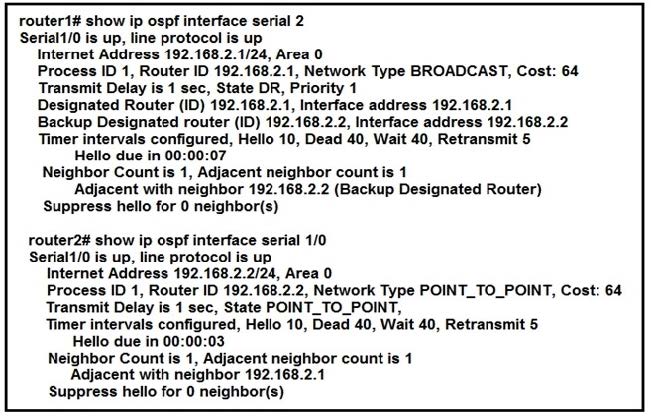
Router1 and Router2 have shared routes in the OSPF database, but the routes are missing from their routing tables. Checking the prefix-list configuration on both routers, the engineer confirmed all networks are allowed. What action should the engineer take to fix the problem?
A. Configure interface Serial1/0 on Router1 as a point-to-point interface
B. Configure the two routers with different process IDs
C. Switch the DR and BDR roles between the two routers
D. Configure the two routers with different hello and dead timer values
Correct Answer: A
Question 3:
Which output from the show isis interface command helps an engineer troubleshoot an IS-IS adjacency problem on a Cisco IOS-XR platform?
A. metric
B. priority
C. circuit type
D. hello interval
Correct Answer: D
RP/0/0/CPU0:XR1#show isis interface | i Cir Tue Jun 29 17:56:42.369 UTC Circuit Type: level-1-2 Circuit Number: 0 Circuit Type: level-1 Circuit Number: 1 RP/0/0/CPU0:XR1#show isis interface | i Hel Tue Jun 29 17:56:46.609 UTC
Question 4:
Referring to the topology diagram show in the exhibit, which three statements are correct regarding the BGP routing updates? (Choose three.)
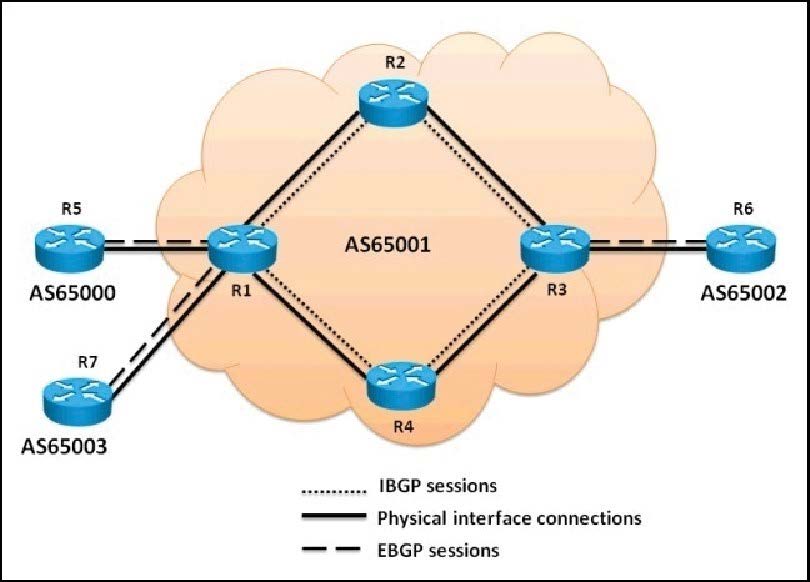
A. The EBGP routing updates received by R1 from R5 will be propagated to the R2, R4, and R7 routers
B. The EBGP routing updates received by R3 from R6 will be propagated to the R2 and R4 routers
C. The EBGP routing updates received by R1 from R5 will be propagated to the R2 and R4 routers
D. The IBGP routing updates received by R3 from R2 will be propagated to the R6 router
E. The IBGP routing updates received by R2 from R1 will be propagated to the R3 router
F. The IBGP routing updates received by R1 from R4 will be propagated to the R5, R7, and R2 routers
Correct Answer: ABD
Question 5:
What is the difference between a source tree and a shared tree in a multicast environment?
A. To route traffic from source to receiver a source tree uses a link-state routing protocol and a shared tree uses a distance-vector routing protocol.
B. A source tree has its root at the source, and a shared tree has its root at a designated rendezvous point.
C. To stream multicast from source to receiver, a source tree uses PIM-SM and a shared tree uses PIM-DM.
D. Source trees are the default type for bidirectional PIM, and PIM-DM uses shared trees by default.
Correct Answer: B
Question 6:
DRAG DROP
Drag and drop the features about multicast from the left onto the multicast protocols on the right. Not all options ate used.
Select and Place:
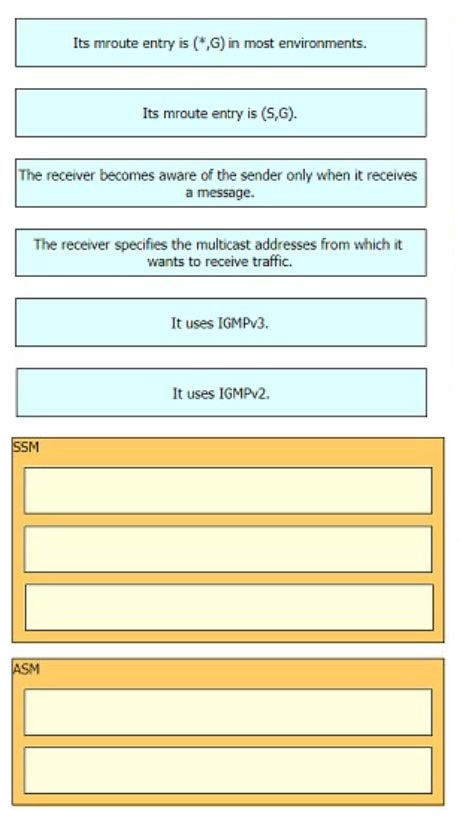
Correct Answer:

Question 7:
Which statement about BFD on Cisco IOS XR Software is true?
A. Cisco IOS XR router must use LDP to route back to the Cisco IOS router to establish the peer relationship.
B. Cisco IOS XR Software does not support BFD multihop for IPv4.
C. Cisco IOS XR router must use dynamic routing or a static route back to the Cisco IOS router to establish the peer relationship.
D. BFD is not compatible between Cisco IOS XR and Cisco IOS Software.
Correct Answer: C
A router running BFD in Cisco IOS software can designate a router running BFD in Cisco IOS XR software as its peer using the bfd neighbor command; the Cisco IOS XR router must use dynamic routing or a static route back to the Cisco IOS router to establish the peer relationship.
Reference: https://www.cisco.com/c/en/us/td/docs/routers/asr9000/software/asr9k-r6-3/routing/configuration/guide/b-routing-cg-asr9000-63x/b-routing-cg-asr9000-63x_chapter_0100.html https://www.cisco.com/c/en/us/td/docs/routers/crs/software/crs_r6-1/routing/configuration/guide/b-routing-cg-crs-61x/b-routing-cg-crs-61x_chapter_0100.html
Question 8:
Refer to the exhibit.
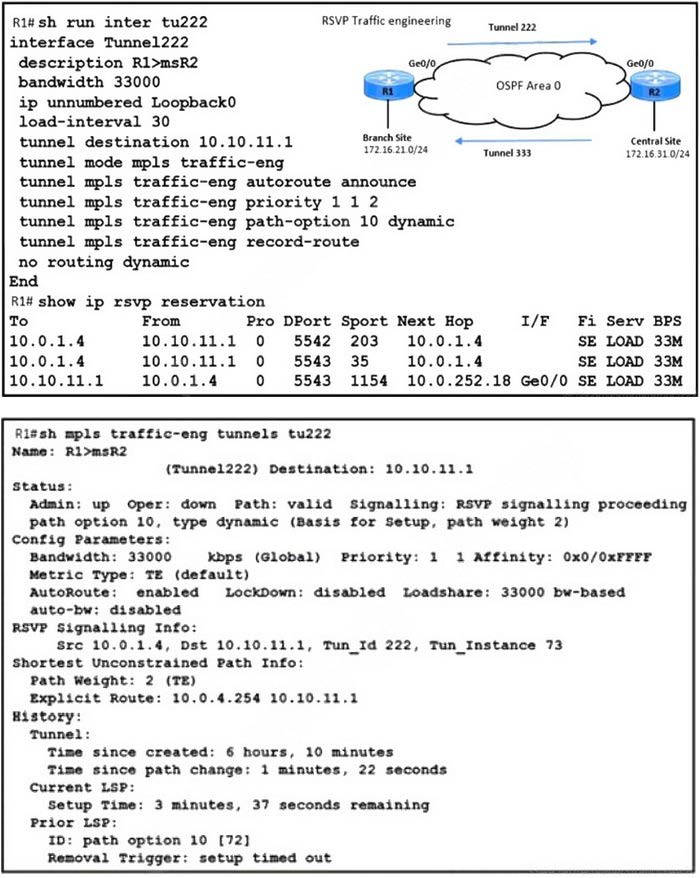
A network engineer is investigating a report of packet drops between the branch site and the central site.
1.
The two sites are connected via OSPF and RSVP-TE tunnels.
2.
Traffic from the central site to the branch site is passing normally.
3.
Technicians at both sites successfully ping the loopback IP addresses on routers R1 and R2.
Which configuration corrects the packet-drop problem?
A. R2(Config)# interface Tunnel333 R2(Config-if)# tunnel mpls traffic-eng bandwidth 33000
B. R1(Config)# interface Tunnel222 R1(Config-if)# tunnel mpls traffic-eng bandwidth 33000
C. R1(Config)# interface Ge0/0R1(Config-if)# ip rsvp bandwidth 33000 3300
D. R2(Config)# interface Ge0/0R2(Config-if)# ip rsvp bandwidth 33000 3300
Correct Answer: C
Question 9:
Refer to the exhibit.
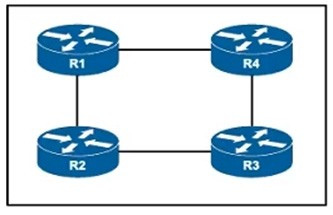
All routers on this network have been configured with PIM-SM, and R1 is the rendezvous point. However, when asymmetric routing is implemented to modify link usage, the network begins to drop certain multicast traffic. Which action corrects the problem?
A. Place the routes affected by asymmetric routing in a VRF
B. Remove the asymmetric routing and use spanning tree to manage link usage
C. Add a static mroute for routes that are failing
D. Configure the routers to use PIM-DM instead of PIM-SM
Correct Answer: C
Question 10:
Refer to the exhibit.
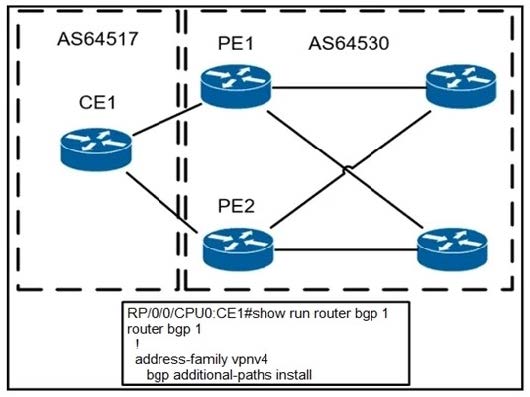
A network operator is configuring BGP PIC on CE1 on already established neighborships with PE1 and PE2 inside the fully converged MPLS network. Which element needs to be implemented to make this feature function effectively?
A. Bidirectional Forwarding Detection must be applied to the upstream facing BGP interfaces
B. The operator must ensure that all prefixes have the same next-hop from PE1 and PE2 for BGP PIC
C. A reserved BGP community of 1:10 must be used to denote the PIC feature set to the routing protocol
D. BGP import/export policies must be applied on all devices for the routes needing BGP for PIC
Correct Answer: A
Question 11:
You have configured MSDP peering between two autonomous systems that pass traffic between two sites, but the peering has failed to come up. Which task do you perform to begin troubleshooting the problem?
A. Verify that multicast has been disabled globally
B. Verify that PIM-DM is configured on the source interface
C. Verify that both source interfaces are reachable from both peers
D. Verify that the two MSDP peers allow asymmetric routing
Correct Answer: C
Question 12:
Refer to the exhibit.

Company A established BGP sessions with several ISPs. A network engineer at the company must filter out all traffic except for routes that transit AS 152.
The engineer configured the filtering policy "permit 152S(_[0.9])" on R1, but after applying the configuration, the engineer notices that other routes are still visible.
Which action resolves the issue?
A. Add a second filtering policy in the format ip access-list 1 permit ^152_([0-9]+).
B. Add a second filtering policy in the format ip prefix-list 1 permit ^152^.
C. Change the filtering policy to ip explicit-path 1 permit $152^.
D. Change the filtering policy to ip as-path access-list 1 permit 152.
Correct Answer: A
Question 13:
Which cost is the default when redistributing routes from BGP to OSPF?
A. 20
B. 1
C. infinite
D. automatic
Correct Answer: B
Reference: http://www.ciscopress.com/articles/article.asp?p=27573
Question 14:
In a PIM-SM environment, which mechanism determines the traffic that a receiver receives?
A. The receiver explicitly requests its desired traffic from the RP on the shared tree.
B. The receiver explicitly requests traffic from a single source, which responds by forwarding all traffic.
C. The RP on the shared tree floods traffic out of all PIM configured interfaces.
D. The receiver explicitly requests traffic from each desired source, which responds by sending all traffic.
Correct Answer: A
A shared tree is built first between receiver and the RP. The receiver is then able to switch to a Source tree as needed.
Question 15:
Refer to the exhibit.
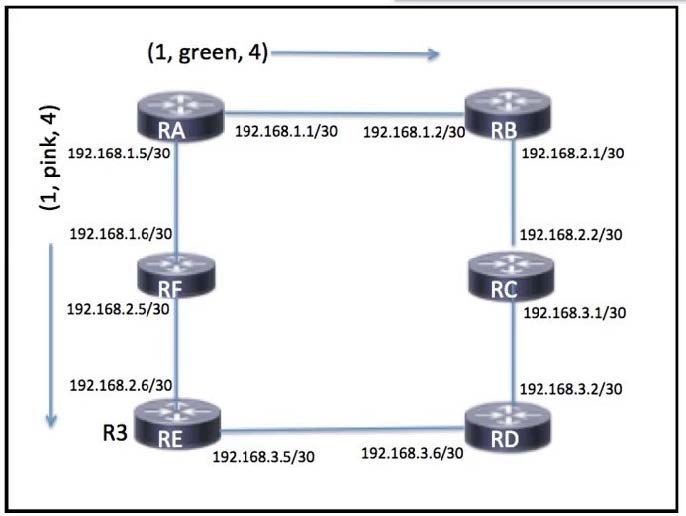
The green policy is designed with low delay, and the pink policy is designed with low cost. What is the next hop for node A on its way to node D, with the objective of achieving a low delay?
A. 192.168.3.2
B. 192.168.1.6
C. 192.168.3.6
D. 192. 168.1.2
Correct Answer: D
…
Finally I want to tell you:
The Leads4pass 300-510 dumps exam material contains 210 latest exam questions and answers. Use https://www.leads4pass.com/300-510.html to download the complete material to help candidates successfully pass the Implementing Cisco Service Provider Advanced Routing Solutions (SPRI) exam.
 Knowt
Knowt
